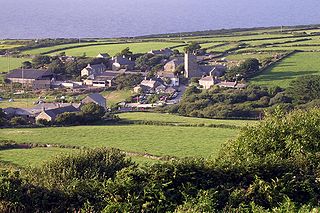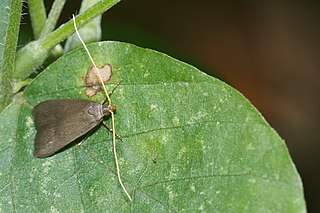
Jasin District is one of the three administrative district in Malacca, Malaysia. It borders Tangkak District of Johor to the east, Tampin District of Negeri Sembilan to the north and Alor Gajah District and Melaka Tengah District to the west. The district capital is Jasin Town.

The Senari languages form a central dialect cluster of the Senufo languages. They are spoken in northern Ivory Coast, southern Mali and southwest Burkina Faso by more than a million Senufo. Three varieties can be distinguished,

Zennor is a village and civil parish in Cornwall, England, United Kingdom. The parish includes the villages of Zennor, Boswednack and Porthmeor and the hamlet of Treen. Zennor lies on the north coast, about 6 miles (10 km) north of Penzance, along the B3306 road which connects St Ives to the A30 road. Alphabetically, the parish is the last in Britain. Its name comes from the Cornish name for the local saint, Saint Senara.
Afega is a village on the island of Upolu in Samoa. It is located on the central north coast of the island to the west of the capital Apia in the countryside. The population is 1998.

The Lecithocerinae are a subfamily of small moths in the family Lecithoceridae. They are found worldwide, but most species occur in South Asia. The subfamily is characterized by the male genitalia with a bridge-like structure connecting the tegumen and the valva, and the uncus almost always is vestigial with two lobes at the dorsal base, only exceptionally united into a broad plate, but never as a thorn or spine.
Costa Rica is divided into three major drainage basins encompassing 34 watersheds with numerous rivers and tributaries, one major lake used for hydroelectric generation, and two major aquifers that serve to store 90% of the municipal, industrial, and agricultural water supply needs of Costa Rica. Agriculture is the largest water user demanding around 53% of total supplies while the sector contributes 6.5% to the Costa Rica GDP. About a fifth of land under cultivation is being irrigated by surface water. Hydroelectric power generation makes up a significant portion of electricity usage in Costa Rica and much of this comes from the Arenal dam.
Senara (Niangolo), one of a cluster of languages called Senari, is a Senufo language of Burkina Faso and Mali.

Zennor Head ; is a 750-metre (2,460 ft) long promontory on the Cornish coast of England, between Pendour Cove and Porthzennor Cove. Facing the Atlantic Ocean, it lies 1 kilometre north-west of the village of Zennor and 1.6 kilometres east of the next promontory, Gurnard's Head. The granite (Killas) cliffs rise over 200 feet (60 m) from the sea and the highest point of the headland is 314 feet (96 m) above sea level, with an Ordnance Survey triangulation station. Zennor Head is on the South West Coast Path, which follows the cliff edge closely, skirting the entire perimeter of the headland. The promontory is part of the Penwith Heritage Coast, and is the largest coastal feature in the United Kingdom that begins with the letter "Z". It gets its name from a local saint, Senara. Zennor Head was mined for copper and tin in the Victorian Era. There is no longer any residential or commercial occupancy on the headland, but it is occupied by a variety of coastal animals and plants, such as kestrels and gorse.
Saint Senara, also known as Asenora, Sinara, or Sennara, is a legendary Cornish saint with links to the village of Zennor on the north coast of Cornwall, UK. The Church of Saint Senara, Zennor is dedicated to her, and according to legend her name inspired the name of the village of Zennor along with local features like Zennor Head and Zennor Quoit.

St Senara's Church, in Zennor Churchtown, Cornwall, England, UK, is the parish church of the parish of Zennor. It is in the Deanery of Penwith, Archdeaconry of Cornwall, and Diocese of Truro. It is dedicated to the local saint, Saint Senara, and is at least 1400 years old, though it was rebuilt in the 12th century. It is a Grade I listed building.

The Mermaid of Zennor is a popular Cornish folk tale that was first recorded by the Cornish folklorist William Bottrell in 1873. The legend has inspired works of poetry, literature and art.
Dyson Stayt "Tug" Wilson was an English international rugby player.
Nanarsine senara is a species of moth of the family Erebidae, subfamily Arctiinae. It is found on Java and Borneo.
Neotimyra is a genus of moths in the family Lecithoceridae.
Neotimyra gyriola is a moth in the family Lecithoceridae. It was described by Kyu-Tek Park in 2011. It is found on New Guinea.
Neotimyra milleri is a moth in the family Lecithoceridae. It was described by Kyu-Tek Park in 2011. It is found on New Guinea.
Neotimyra nemoralis is a moth in the family Lecithoceridae. It was described by Kyu-Tek Park in 2011. It is found on New Guinea.
Neotimyra warkapiensis is a moth in the family Lecithoceridae. It was described by Kyu-Tek Park in 2011. It is found on New Guinea.
Senara or SENARA may refer to:






